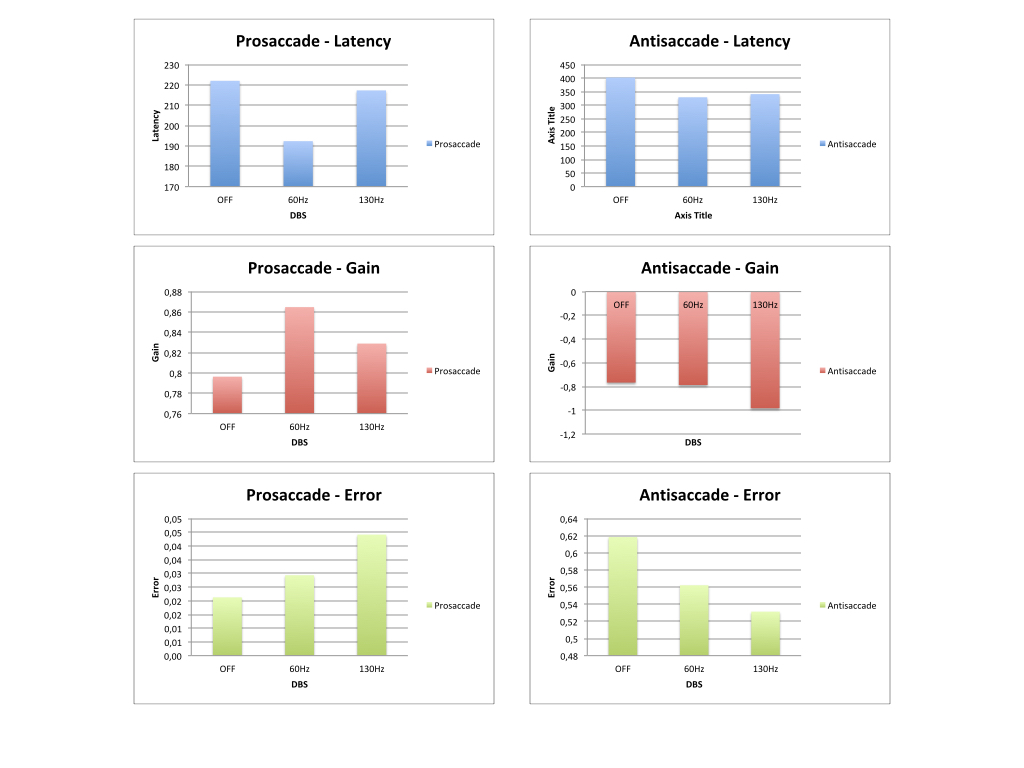Session Information
Date: Wednesday, September 25, 2019
Session Title: Surgical Therapy
Session Time: 1:15pm-2:45pm
Location: Les Muses Terrace, Level 3
Objective: Compare the effects of subthalamic stimulation using high versus low frequency on saccadic and antisaccadic eye movements of idiopathic PD patients.
Background: Parkinson’s disease (PD) is associated with several eye movement abnormalities. The study of saccades and antisaccades is of special interest once their mechanisms involve different cerebral brainstem areas. The effects of deep brain stimulation on eye movement are poorly known. Some researches suggest that bilateral high frequency subthalamic (STN) stimulation reduces latency in the prosaccade, increases gain of antisaccadic task and apparently have no effect on antisaccade latency. A recent study associated antisaccadic latencies with postural instability. We hypothesized that low frequency stimulation and high frequency stimulation could have different prosaccadic and antisaccadic patterns due to their different effects on gait and balance.
Method: We included 08 patients with PD treated with bilateral subthalamic deep brain stimulation. The patients were evaluated with DBS at OFF, high frequency (130hz) and low frequency (60hz) stimulation with constant total electrical energy delivered (TEED). The tests were performed with the patients in OFF medication and consisted of eyetracking battery, with prosaccades and antisaccades paradigms.
Results: The mean latency of prosaccades was 222,03 (± 61,28) for OFF stimulation, 192,37 (± 26,13) for 60Hz and 217,31 (± 40,47) for 130Hz. The prosaccadic gain was 0,80 (± 0,20) for OFF stimulation, 0,86 (± 0,08) for 60Hz and 0,83 (± 0,14) for 130Hz. The error at prosaccade was 0,02 (± 0,05) for OFF stimulation, 0,03 (± 0,04) for 60Hz and 0,04 (± 0,12) for 130Hz. Regarding to antisaccades, the latency varied from 402,28 (± 112,26) for OFF stimulation, 329,51 (± 60,11) for 60Hz and 341,22 (± 34,33) for 130Hz. The gain was -0,77 (± 0,41) for OFF stimulation, -0,79 (± 0,48) for 60Hz and -0,98 (± 0,42) for 130Hz. The anti saccadic error was 0,62 (± 0,18) for OFF stimulation, 0,56 (± 0,23) for 60Hz and 0,53 (± 0,21) for 130Hz.
Conclusion: Our findings seems to corroborate previous data showing that OFF stimulation mode had the higher prosaccadic and antisaccadic latency, we also demonstrate that low frequency stimulation had the lower latencies. The error showed opposite results for prosaccadic and antisaccadic paradigms, there was an increase of error at prosaccadic and a decrease of error with stimulation.
To cite this abstract in AMA style:
MG. Ghilardi, L. Stock, C. Kruger-Zechlin, Z. Deeb, E. Fonoff, L. Timmermann, J. Waldthaler. Comparison of high versus low frequency subthalamic stimulation on eye movement [abstract]. Mov Disord. 2019; 34 (suppl 2). https://www.mdsabstracts.org/abstract/comparison-of-high-versus-low-frequency-subthalamic-stimulation-on-eye-movement/. Accessed December 5, 2025.« Back to 2019 International Congress
MDS Abstracts - https://www.mdsabstracts.org/abstract/comparison-of-high-versus-low-frequency-subthalamic-stimulation-on-eye-movement/

